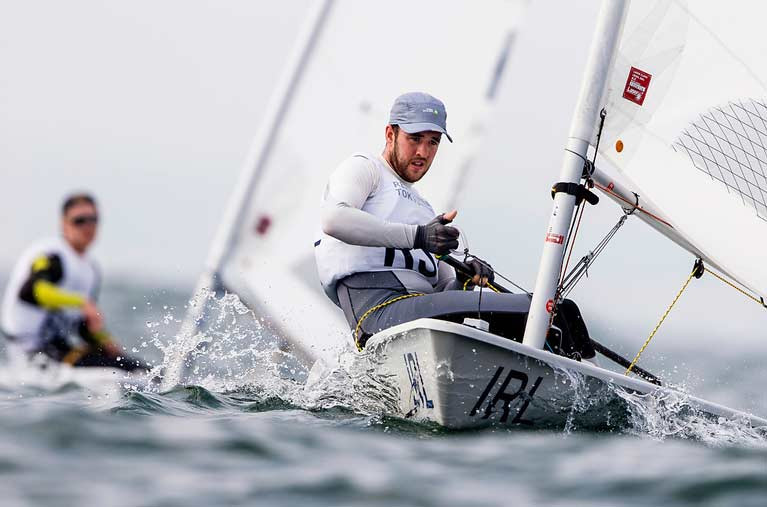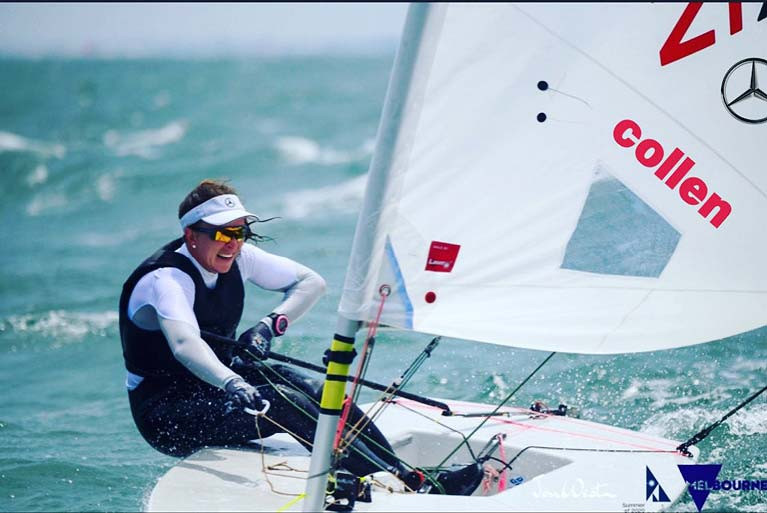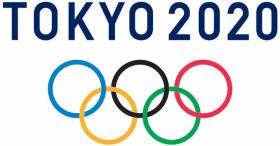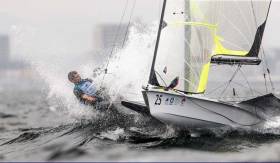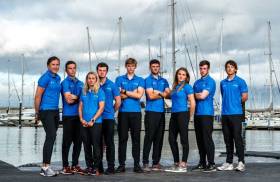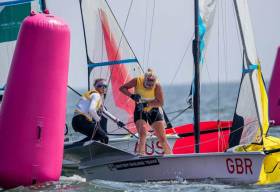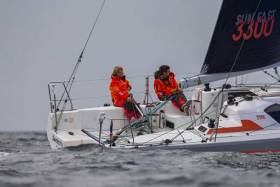Displaying items by tag: olympic sailing
Virtual Regatta Esailing Game Gets Olympic Class Regatta Sites
World Sailing, the International Federation for the sport, and Virtual Regatta, the world-leading digital sailing platform, have launched several iconic Olympic class regattas in the eSailing world.
Regattas around the globe have been cancelled or postponed due to the Novel Coronavirus (COVID-19) pandemic - but eSailors will now be able to compete at some of the world's best-known sailing events online.
These events include:
- Trofeo Princesa Sofia
- World Cup Series, Genoa
- Kiel Week
eSailors can compete at Trofeo Princesa Sofia on Virtual Regatta from yesterday (Monday 30 March until 3rd April), at the World Cup Series, Genoa from 11th – 18th April, and at Kiel Week from 20th – 28th June, while other events will be launched at a later date.
Both World Sailing and Virtual Regatta have worked closely with each regatta to recreate each one as a virtual racecourse, available for eSailors all over the world to take part in.
In the current climate, it's more important than ever for us to feel connected with the rest of the sailing community. Making these world-famous Olympic class events accessible to everyone online gives us the chance to engage sailors of all ages and backgrounds, allowing all involved to continue to share their passion for the sport.
Recently there has been a huge increase in active daily users on Virtual Regatta Inshore, rising from 5,000 at the start of the year to around 18,000-20,000 and peaking at 25,000 this week.
At each regatta, the 49er and the Nacra 17 will be available for players to race at virtual replications of these real-life sailing venues.
The first few days of each event launch will consist of challenges. Ranked Medal Races will take place over the final two days, open to all players – no qualification for these races is necessary, but results will count towards World and National rankings for eSailors!
Additionally, Hempel World Cup Series Genoa will qualify as a 'blue challenge,' meaning the opening challenges will also count towards the official eSailing World Championship ranking.
These Medal Races for these challenges will also provide an opportunity for two eSailors (one from the 49er and one from the Nacra) to qualify for the eSailing World Championship Playoffs.This will give eSailors a chance at qualifying to the Live Final, where the 2020 eSailing World Champion will be crowned.
Existing eSailors and new players are invited to compete in these classic regattas for free from today!
The first challenge is available now and can be played on Virtual Regatta Inshore on Desktop – iOS – Android.
How Will Irish Olympic Sailors be Impacted if New Qualification Rules Apply for Last Tokyo Places?
What chances has Ireland got for the last Olympic places in the Finn, 49er and men's Laser classes if qualification changes are made?
The IOC, in their determination to maintain normality – or to return to normality as soon as possible – have issued a position update on the 2020 Tokyo Olympics and the potential changes to the qualification process disrupted by the spread of Covid-19.
Many sports, including sailing, have had to cancel qualifying events and the IOC has asked International Federations to consider revising the qualification process which may include ranking or historical results. For athletes planning to use the remaining events to qualify, this could mean the end of their road to Tokyo, and in some cases, the end of their careers. The negative implications of a revised qualification system have put athletes and the IOC at loggerheads, particularly as there are different restrictions on athlete training regimes across sports and countries.
It is hard to believe that the Games will run on schedule, not because of the state of play in August, but because a revised qualification system will surely end up in the Court of Arbitration for Sport when potential qualifiers feel excluded.
The IOC has declared a number of principles as follows:
- All quota places that have already been allocated to date remain allocated to the NOCs and athletes that obtained them.
- The possibility remains to use existing and scheduled qualification events, wherever these still have fair access for all athletes and teams.
- All necessary adaptations to qualification systems and all allocation of remaining places will be:
a) based on on-field results (e.g. IF ranking or historical results); and
b) reflect where possible the existing principles of the respective qualification systems (e.g. use of rankings or continental/regional specific event results).
If, as seems increasingly likely, ranking or historical results are used to determine sailing’s Olympic qualifiers, then how will Irish sailors be impacted?
Finn
Ireland is well out of the running here, both on ranking and results from the most recent Gold Cup. There is one European slot remaining, but the same six as yet to qualify countries that finished ahead of Ireland at the Gold Cup are also ahead of Ireland in the world rankings.
Laser
There are two European places yet to be won or allocated with four countries in the running – Belgium, Netherlands, Italy and Ireland. While Ireland finished behind all of these at the latest World Championships, Irish Laser Sailor Finn Lynch is ranked 13th, just one place behind the Italian. The top-ranked Belgian is 21st, while the Dutch ranking is 45th. In this case, a world ranking determination would see Ireland qualify for the Games.
49er
Ireland is vying with Belgium, Sweden and Italy for the one remaining European place. Form at the 2020 Worlds suggested that Irish sailors would be favourites having finished ahead of the other three candidates, but they are the lowest in a tightly packed group in the world rankings.
There is no doubt that no matter what option is chosen by World Sailing, the outcome will disadvantage some, benefit others, possibly leading to challenges at higher levels. Ireland may increase its representation in Tokyo, but only by one whether rankings or form is used. In this case, where the wisdom of Solomon is required, it appears the baby will end up in two parts no matter what.
Ireland's bid for two further Tokyo Olympic 2020 places will be rescheduled after the cancellation of World Sailing's World Cup Series Genoa event that was due to be held in the Italian city from 11 – 19 April 2020 due to Novel Coronavirus (COVID-19).
As Afloat reported previously, following the outbreak of COVID-19 in Italy, World Sailing has been in regular contact with the Federazione Italiana Vela (FIV), the local organisers, and the Italian Government, receiving updates and closely monitoring the situation.
After a four year journey, Ireland is seeking the final places available in both the men's Laser dinghy and men's 49er skiff classes.
The World Sailing Board has also consulted the World Sailing Medical Commission prior to making this decision.
The decision was made to ensure the health and well-being of the sailors, support personnel, officials and volunteers, a top priority for World Sailing.
Hundreds of sailors, however, continue to arrive on the Spanish island of Mallorca for the Trofeo Trofeo Princesa, another Olympic regatta that takes place this month.
Hempel World Cup Series Genoa was to act as the final opportunity for Tokyo 2020 Olympic qualification for African, Asian and European sailors in a number of the Olympic Sailing Events. The International Olympic Committee (IOC) has granted World Sailing an extension of the qualification period to 30 June 2020.
World Sailing is now working in close collaboration with the IOC and Event Organisers to reschedule the remaining African, Asian and European Tokyo 2020 Olympic qualifiers and to ensure that all quota places can be allocated.
Further updates on qualification events will be issued by World Sailing with formal updates applied to the Tokyo 2020 Olympic Sailing Qualification System here.
With Ireland having secured one of the last places in the Laser Radial class at the Tokyo 2020 Olympic Games and with four sailors now set to contest a trials series for the single place, the Irish Sailing procedures for the 2020 Olympic Games Trials have been ratified by the Olympic Federation of Ireland and are downloadable below as a PDF document.
Ireland’s Laser Radial Olympic Berth
As Afloat previously reported, a three trial regatta series will be used to identify the Irish Sailing Team nominee. The following trial regattas will be used for the Laser Radial Class:
- ILCA Laser Radial Women’s World Championship, Melbourne, Australia, 21-28 February 2020 (this replaces the Genoa WC Round 2020)
- Trofeo Princesa Sofia, Palma, Spain. 28 March – 4 April 2020
- Hyéres Regatta, France, 18 – 25 April 2020
Lasers and 49ers Chasing Final Olympic Places
While neither the Laser Men or the 49ers have yet secured country qualification, both will compete in Genoa this April at the European qualifier with two final Olympic places available in the Laser class and one in the 49er. Whoever qualifies Ireland for an Olympic spot will automatically represent the nation in Tokyo this Summer.
Download the full nomination document below.
Annalise Murphy Shows Form in Return to Radial Tokyo 2020 Competition in Melbourne
Rio Olympic silver medallist Annalise Murphy marked her return to the Laser Radial with some reliable performances at the Australian National Championships in Melbourne this week. Her scoresheet included a race win as David O'Brien reports in this morning's Irish Times Sailing column here.
Next up for four Irish sailors, including Murphy, in the only Irish boat qualified so far for Tokyo 2020, is an Olympic trial series starting in March.
Much more in the Irish Times here.
The Olympic Federation of Ireland is delighted to announce the Tokyo 2020 Team Ireland Performance Support Leads, who will play an integral role in supporting the athletes during the Olympic Games. The Sport and Science leads will be operating under the direction of the Chef de Mission, Tricia Heberle, and the Olympic Games Head of Performance Support, Phil Moore, and will deliver and integrated performance support system to Irish athletes and staff to enable them to perform to their full potential at next year’s Games.
The nomination of the Sport and Science leads is being announced on the back of a rigorous and competitive selection process, and there will be a dual focus on the pre-games training camp environment and on the Games themselves.
|
Tokyo 2020 Lead Support Role |
Name |
Organisation |
|
Strength & Conditioning / Holding Camp Deputy Manager |
Eamonn Flanagan |
SII |
|
Performance Nutrition / Holding Camp Deputy Manager |
Dr Sharon Madigan |
SII |
|
Performance Physiology |
Declan Gamble |
SINI |
|
Olympic Transition Support |
Eoin Rheinisch |
SII |
|
Performance Psychology |
Dr Kate Kirby |
SII |
|
Sports Medicine (Chief Medical Officer) |
Dr Jim O’Donovan |
SII |
|
Sports Physiotherapy |
Sarah Jane McDonnell |
SII |
The Performance Support Leads will work as part of a multi-disciplinary Science and Medicine leadership team. Their focus will be on supporting the wellbeing of the athletes and staff before, during and after the Games.
“I am very excited about the calibre and experience of our Team Ireland Performance Support leads,” Chef de Mission Heberle said, “Tokyo 2020, like every Olympic Games, will present challenges and a range of considerations that we need to embrace and effectively prepare for. The support and expertise of these highly experienced practitioners and leaders in their fields will be invaluable to myself, our athletes and staff across Olympic qualification and at the Games.
“Many of our leads are already working with sports that will qualify for the Games and so our aim is to ensure a balance of continuity of support while also providing leadership and direction to a network of practitioners at the Sport Ireland and Sport NI Institutes, and in National Federations.”
Head of Performance Support Phil Moore added, “The appointment of the Performance Support Leads for the Tokyo Olympics is a significant milestone in the development of a world class high performance system in Ireland. The robust and transparent recruitment process ensures continuity of support for our athletes through the full Olympic cycle, delivered by a highly experienced team of science and medical practitioners working closely with Performance Directors and coaches.
“I look forward to working with this team and with the Team Ireland Chef de Mission Tricia Heberle to support our athletes and coaches in the preparation for Tokyo 2020.”
The Olympic Games take place in Tokyo from the 24 July to the 9 August 2020. Irish athletes are currently in the qualification stages across their sports.
49er Duo Seaton & Guilfoyle Tenth at First Round of 2020 World Cup
Ryan Seaton and Seafra Guilfoyle were best of the Irish at the first round of the World Sailing Cup in Enoshima, Japan last week. The Belfast-cork partnership, who still seek the Olympic qualification standard for Tokyo 2020, made the medal race cut and finished in sixth place in that finale to 10th place overall.
In a big improvement for the pair, they had been as high as fifth overall during the heavy weather series, so in the context of their campaign to reach the Olympic standard later this year, they will rue race four in which they did not finish and race seven where they were disqualified.
Watch the duo in action in the medal race below (you can skip to 2:49:00)
With the World Cup in Enoshima now finished, it brings to a close what officials say was 'a really productive summer of sailing' for Ireland and one where Olympic qualification was achieved by Lough Derg's Asiling Keller in the Radial class.
Ireland will seek to qualify for Tokyo 2020 at the last opportunity later this year in the 49er and 49erFX skiff classes and next March in the men's Laser class.
Australia’s Mat Belcher and Will Ryan won their third consecutive Men’s 470 gold medal on the Tokyo 2020 Olympic waters as the Hempel World Cup Series Enoshima event in Japan concluded.
Belcher and Ryan won the 470 World Championship title on 9 August and followed up with Ready Steady Tokyo, the Olympic test event, success on 22 August.
After five weeks of hard racing in Enoshima, they will head home, take stock of their success during a period of rest and move into 2020, the Olympic year, full of confidence.
The Men’s 470 Medal Race was one of two that was completed on a light wind final day on Sagami Bay. The Women’s 470 sailed the second and Spain’s Silvia Mas and Patricia Cantero came from behind to grab gold.
Light winds saw the postponement of the Laser, Laser Radial and Finn Medal Races which meant the results overnight stand. Nicholas Heiner (NED) and Pavlos Kontides (CYP) had already confirmed gold before the Medal Race in the Finn and Laser.
Emma Plasschaert (BEL) was prepared to fight Anne-Marie Rindom (DEN) and Alison Young (GBR) for gold in the Laser Radial. The cancellation confirmed Plasschaert as victor in Enoshima for the second time in ten days after she won Ready Steady Tokyo.
The Hempel World Cup Series will head to Miami, USA in January 2020 as the countdown to the Tokyo 2020 Olympic Games continues. -- Daniel Smith - World Sailing
Final podium positions:
470 Men
1. Mathew Belcher / William Ryan, AUS, 27
2. Jordi Xammar Hernandez / Nicolás Rodriguez Garcia-Paz, ESP, 37
3. Kazuto Doi / Naoya Kimura, JPN, 47
470 Women
1. Silvia Mas Depares / Patricia Cantero Reina, ESP, 44
2. Nia Jerwood / Monique de Vries, AUS, 45
3. Frederike Loewe / Anna Markfort, GER, 58
49er Men
1. James Peters / Fynn Sterritt, GBR, 49
2. Benjamin Bildstein / David Hussl, AUT, 49
3. Tim Fischer / Fabian Graf, GER, 52
49erFX Women
1. Annemiek Bekkering / Annette Duetz, NED, 27
2. Alexandra Maloney / Molly Meech, NZL, 36
3. Julie Bossard / Aude Compan, FRA, 37
Finn Men
1. Nicholas Heiner, NED, 19
2. Josip Olujic, CRO, 44
3. Ioannis Mitakis, GRE, 47
Laser Men
1. Pavlos Kontides, CYP, 36
2. Matthew Wearn, AUS, 57
3. Jean Baptiste Bernaz, FRA, 62
Laser Radial Women
1. Emma Plasschaert, BEL, 54
2. Anne-Marie Rindom, DEN, 57
3. Alison Young, GBR, 64
NACRA 17
1. Quentin Delapierre / Manon Audinet, FRA, 21
2. Ben Saxton / Nicola Boniface, GBR, 22
3. Ruggero Tita / Caterina Marianna Banti, ITA, 23
RS:X Men
1. Louis Giard, FRA, 48
2. Kun Bi, CHN, 49
3. Pierre Le Coq, FRA, 53
RS:X Women
1. Yunxiu Lu, CHN, 37
2. Katy Spychakov, ISR, 42
3. Zofia Noceti-Klepacka, POL, 49
Full results including Irish places here
Irish Olympic Sailing Team Compete at Sailing World Cup in Japan
The Irish Olympic Sailing Team are still in Japan following the Olympic Test Event earlier this month and compete in the World Sailing World Cup in Enoshima. Racing started today (26 August) until 1 September.
The World Cup series is open to all the sailing classes chosen for the 2020 Olympic competition, and the series moves around the world to be as inclusive as possible to the top 40 boats in each class.
The full Irish Sailing Team is competing with Aoife Hopkins and Aisling Keller in the Laser Radial; Finn Lynch and Liam Glynn in the Laser; Ryan Seaton and Seafra Guilfoyle, Robert Dickson and Sean Waddilove in the 49ers; Annalise Murphy and Katie Tingle in the 49erFX.
Royal Irish's Saskia Tidey Leads at 'Ready Steady Tokyo' in Japan
The Royal Irish Yacht Club's Saskia Tidey from Dun Laoghaire leads the 'Ready Steady Tokyo' regatta competing for Team GBR in Japan where Irish team results to date are mixed.
A day of light wind saw a slightly disrupted race schedule on Day 2 in the official test event of the Tokyo 2020 Olympic Sailing Competition.
But, after a short postponement, all fleets managed to get out onto the water and complete at least one race each, with four days remaining to sail the rest of the series.
Compared to yesterday’s strong breeze and big waves, conditions today were quite different and required sailors to adapt in order to maintain consistency.
One team which has done this very well is the pairing of Charlotte Dobson and Tidey (GBR) in the 49erFX fleet.
Their lowest result out of five races so far is a fourth, with two second places today to add to yesterday’s two wins.
And the duo are unsurprisingly very satisfied with how they have managed the conditions so far.
“Today was lighter than yesterday with around 10 knots,” explained Tidey.
“We were on the Kamakura course today and we had quite a left-handed racetrack to start with; we luckily got into the second race before it switched around to sea breeze.
“Today the sea state was a lot flatter – we had a bit of swell coming in, but nothing like yesterday.
“Yesterday was more about boat-handling and keeping the boat moving through the water.”
On their impressive start to Ready Steady Tokyo, which sees them lead by six points after five races, Tidey added, “We’re thrilled – it’s the way anyone would hope to start a regatta.
“We’ve got a long week ahead; we just have to keep our heads and keep going.”
Behind them in second are Martine Grael & Kahena Kunze (BRA), with Helene Naess & Marie Rønningen (NOR) moving into the top three. Both teams picked up a race win and a fifth place today.
Former Rio team-mate Annalise Murphy and Katie Tingle now competing against Tidey in the 49erFX are 21st in the 23-boat fleet.
Maria Erdi (HUN) keeps her lead in the Laser Radial fleet, despite finishing 35th in the only race of the day, which now becomes her discard.
Nearest challengers Marit Bouwmeester (NED) and Anne-Marie Rindom (DEN) also recorded results out of the top 10, coming 23rd and 14th respectively.
Viktorija Andrulyte (LTU) secured the victory in that solitary race.
Unusually, Ireland has been permitted two Radials in the event and Aoife Hopkins is 26th and Aisling Keller is 29th in the 40-boat fleet after three races sailed.
Finn Lynch is 13th
There was only one race sailed in the Laser fleet, too, with Chris Barnard (USA) claiming the win.
Finn Lynch, of Dun Laoghaire, has moved up to 13th overall in the Laser class after scoring a a six in race three.
Fleet leader Sam Meech (NZL) is one point ahead of new top-three entry Hermann Tomasgaard (NOR), with Jean Baptiste Bernaz (FRA) finishing 25th but discarding that to keep third.
The 49er fleet also managed to sail two races despite heading out later, which has changed the look of the top three.
Leading the way now are Lukasz Przybytek & Pawel Kolodzinski (POL) who, although they are yet to win a race so far, have notched some fairly consistent results.
Peter Burling & Blair Tuke (NZL) relinquish their opening-day lead after finishing 13th (discarded) and ninth today, with Benjamin Bildstein & David Hussl (AUT) entering the top three.
Today’s race wins went to Mathieu Frei & Noe Delpech (FRA) and Mads Emil Stephensen Lübeck & Nikolaj Hoffmann Buhl (DEN).
Ireland's Robert Dickson and Sean Waddilove are 20th from 21 in that class.
Racing continues tomorrow, with all fleets departing at around 12:00 local time. All are scheduled to sail three races, apart from the 49er, 49erFX and Nacra 17 fleets, which will sail four.
Mixed Olympic Keelboat Class for Paris 2024 Has Irish Interest
As the Irish Olympic Sailing team embark on this week's Pre-Olympic regatta in Enoshima, Japan the fact that only one of four Irish campaigns have yet qualified will be occupying minds just a year out from Tokyo 2020.
The prospect then of a new Olympic class for Paris 2024 will not have escaped some incumbents who may be weighing up the notion of a class change given there's always the chance this new keelboat might offer a different (or easier?) qualification path in four years time.
Existing squad members, however, are not the only ones eyeing up the Mixed Two Person Offshore Keelboat.
The race is already on with a declaration of interest from outside the camp by offshore sailor Conor Fogerty of Howth Yacht Club and sailing partner Susan Glenny who are already competing in the foiling Beneteau Figaro 3 keelboat they have named, Raw.
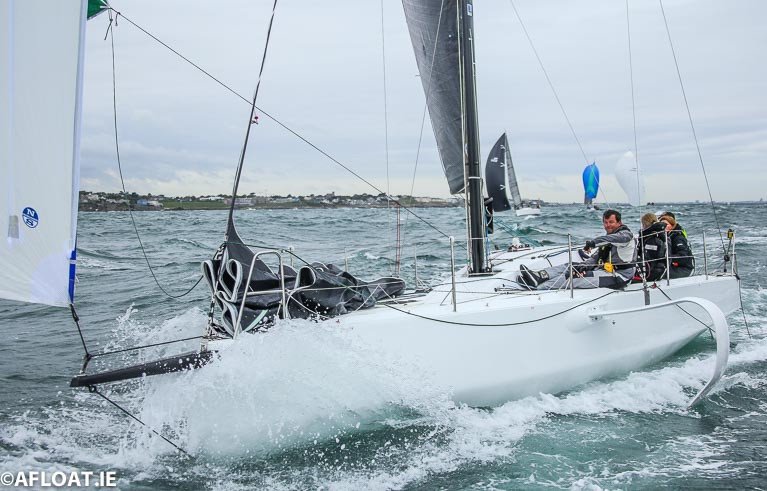 Conor Fogerty's new foiling keelboat, Raw
Conor Fogerty's new foiling keelboat, Raw
Certainly, there is a big welcome for the return of the keelboat to the Olympic line-up but already hefty price tags are being attached to such campaigns. Regardless of price, however, we can be certain that for the first time in sailing’s Olympic history, a Mixed Two Person Offshore Keelboat event will be on the programme at the Olympic Sailing Competition in 2024.
The Mixed Two Person Offshore Keelboat will join kiteboarding, windsurfing, multihulls, singlehanded and doublehanded dinghies and skiffs, promoting the diversity of the sport.
This in turn will support World Sailing’s desire to promote and grow universality in all disciplines and increase female participation with gender-equal medals and athletes.
To showcase the event and how it may look at Paris 2024, World Sailing has launched this promotional film below
More than 70% of the globe is water – sailing’s field of play – and offshore sailing is played out across long distances in both light and strong wind conditions and a variety of sea states that test an athletes resolve. Offshore sailing is the ultimate test of endurance , skill, discipline, navigation and critical decision making.
Embracing a major part of sailing in the Paris 2024 Olympic Games will enable new stars of the sport to come to the forefront.
Qualification
Offshore sailing is a universal discipline that every World Sailing Member National Authority (MNA) can participate in.
Up to 20 nations will be on the startline at Paris 2024 and sailors from every continent will be represented. To qualify for the Olympic Games, continental qualification events will be held and competition for a spot will be fierce.
Equipment
For qualification events, World Sailing will approve a list of one-design boats that are already regionally available and can be accessed as a charter boat. Boats will be equalised to ensure fair competition.
For Paris 2024, World Sailing’s Council will select a list of different Equipment it considers to meet the key criteria by 31 December 2020 and then make a decision on the Equipment, selecting from the list, no later than 31 December 2023.
MNAs, Class Associations and Manufacturers have all been invited to propose Equipment for the list and a World Sailing Working Party will evaluate each proposal. A recommended list will be presented to Council for approval in November 2020.
This recommended Equipment list will ensure that event organisers, MNAs and the sailors have opportunities to train and compete in Equipment that is readily available and affordable within their continent and country. It will also ensure each MNA has a fair opportunity to prepare for qualification events and eventually, Paris 2024.
Format
Starting and finishing in Marseille, the Mixed Offshore event is expected to last for either three days and two nights or four days and three nights off the French coastline and whoever crosses the finish line first will be declared Olympic champion.
The race course and length will be announced in the lead up to the start so the competition can take advantage of the latest weather forecast. Current options proposed include long and short courses heading towards the West and East of France.
Safety and Security
The French Navy and Mediterranean forces have extensive experience of supporting major oceanic sailing races. They will provide safety and security at Paris 2024.
At the recent Hempel World Cup Series Final in Marseille, France, a demonstration of safety and security procedures was presented to the sailors, coaches and officials.
Media and eSailing
The Olympic programme features 28 sports, all fighting for broadcast time and space in written and digital publications.
The Mixed Offshore event will be the longest and toughest of all Olympic sporting events and will bring a new appeal to Olympic rights-holding broadcasters and international media.
Available to follow via broadcasting and live tracking, the race is expected to capture the imagination of millions and will be the first Olympic event that can be viewed 24 hours a day.
Live broadcasting, tracking and analytics directly from each boat and onboard cameras will give global media insight into life onboard and to tell compelling stories to inspire existing and new fans of the sport.
eSailing has emerged as a true touch point for sailors and non-sailors alike and for the first time in the history of any Olympic sport, tens of millions of sailing and Olympic sports fans will also have the opportunity to compete virtually and simultaneously as the Mixed Offshore event, comparing themselves to the real-life Olympians.





























